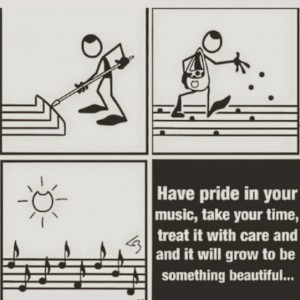5 Rules to live by for practicing:
1. Practice it, don’t perform it.
I like to view practice as an environment where I’m totally in control. It is my time to work on what I think is most important for the day. I will often start with something that I am least familiar with, such as a new or difficult passage and break it down in a slow, controlled and enjoyable way. Whether I’m composing or learning a piece, I always view it as a project or a process, kind of like building furniture or tending to a garden. It’s always important to try and explore the newer areas of your music as soon as possible, that way you do not get stuck in the addictive habit of performing.
What I mean by performing is playing sections that you already are comfortable with over and over again. Not only does this take away from the rest of your piece by making a certain section sound better than the others, but it makes unknown sections seem more intimidating than they actually are. Performing is a form of procrastination.
I like to use performance as a reward for practice. For example, I will practice a new section for 5 minutes, or 20 repetitions, then I will go to a section that I know well and perform it for a minute, or 2-3 repetitions.
The overall goal is to practice a piece so well that eventually you will spend most of your time performing the piece in its entirety and practice small sections every now and then to keep it maintained.
2. Go Slow
Seriously, if there is one rule that you follow out of these 5, follow this one. Slowing down, especially on unfamiliar or difficult sections opens up your mind to all of the details that the composer of the piece intended for you to follow. Slowing down takes the tension out of playing a difficult passage. Slowing down allows you to think and live in the moment instead of feeling like you are behind. Slowing down lets you have fun with what you are working on. Slowing down makes practice easy.
3. Take breaks
Music is hard and demands a fair amount of concentration, fortunately taking breaks refreshes your mind and keeps you from getting burned out on learning new information. Go play a video game, take a walk, listen to your favorite cheesy 80’s motivational song (I recommend “Highway to the Danger Zone by Kenny Loggins), hug your mom, or do some pushups and then get back to that section that was giving you trouble.
4. Use different approaches
If you change the way that you practice certain sections, your mind is forced to perceive the music in different ways, keeping the piece more interesting to you. One of my favorite approaches is to completely ignore the dynamic markings on the music (the volume) and to create my own. Another fun one is to add pedal to sections that don’t need it, or take pedal away from sections that sound naked without it, just to see what it sounds like. While you are not directly contributing to the end product the piece you are working on, you are directly contributing to your musical education by experimenting with all of the elements that composers use to create their own music.
5. Be consistent
I’ve always believed that consistency is more powerful than quantity. I believe that a student can only commit to 15 minutes a day will make more progress than an equally skilled student who practices for an hour, twice a week. If you do this while using rules 1−4, you will make progress.
We are often afraid of what we don’t understand. Difficult sections of music can seem impossibly difficult at a glance, which often times is correct; it is impossible to play the section that you are looking at perfectly at that given moment. That’s why we practice. Rules 1−5 will greatly help you to gain facility with difficult sections of music. Break it down into smaller, more manageable chunks and have fun with it! Just because something is difficult doesn’t mean you can’t have fun with it!

